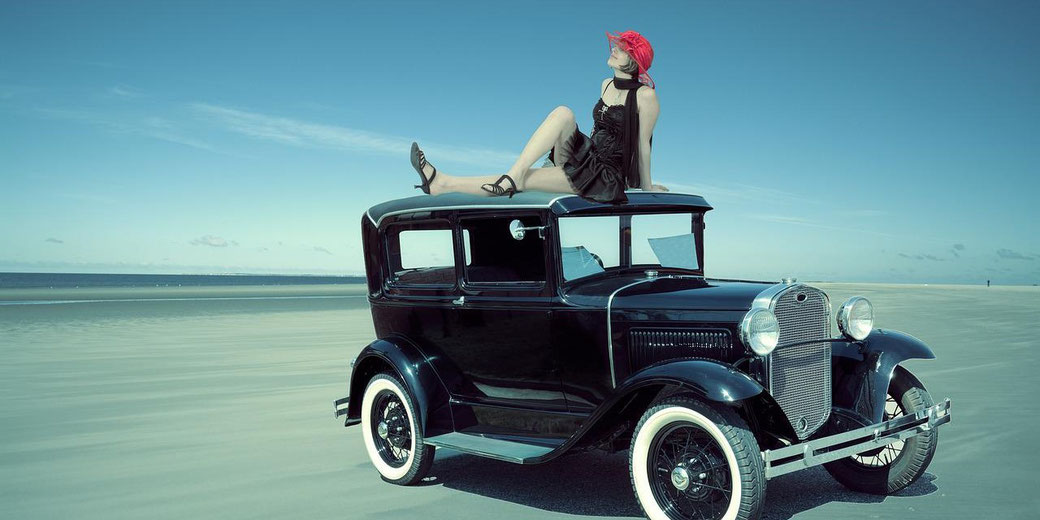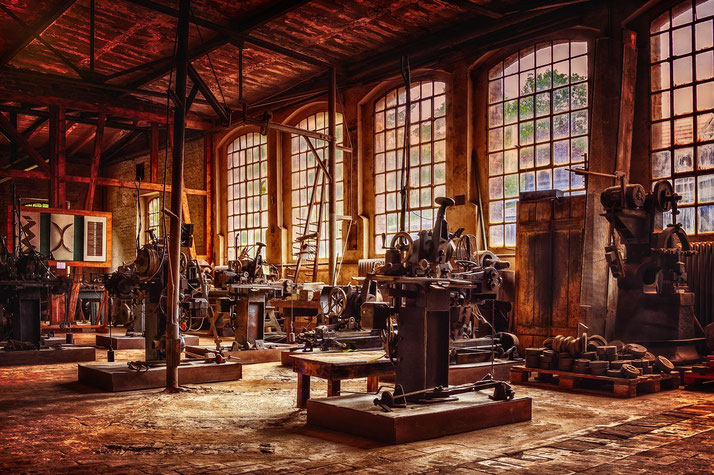The craziness of the Roaring Twenties in America

The Roaring Twenties was a period of time, roughly about a decade long from 1920 to 1929, and is often described as a period of fun and enjoyment.
The United States in particular, was the cultural centre of this time period, as US companies experienced a significant economic boom in production and profits.
The amount of money people had increased during the time, and they spent this new money on new kinds of music, dances and going to new cinemas.
Also, the cash was spent on new luxury items such as automobiles, radios and fashions, which were all made possible by the rise of mass production factories.
Background and causes
By 1920, the world was emerging from a very difficult period of time. The First World War had caused untold devastation to many countries, particularly in Europe.
Since the conflict began in the middle of 1914, many western societies had invested their entire economies and factory production into supporting the war effort.
By 1917, countries like Germany, France, and Britain were struggling with raising enough money to fund their aims.
When the United States eventually joined the First World War on the side of the allies, they were able to provide a huge boost in resources and manpower.
Hundreds of factories in America, both big and small, were able to turn their machines to producing the weapons and ammunition required to supply the new US armed forces when they began fighting in 1918.
When World War One ended in November 1918, millions of men from dozens of countries returned home with deep physical and mental scars.
Many people assumed that life could return to normal.
Unfortunately, a global pandemic then hit the world. The Spanish Flu sent many countries into lock-down as millions of people died.
It wasn't until the end of 1919 that people started to feel like they could finally return to the way life used to be before the war began in 1914.
The economic boom explained
As 1920 began, the United States were uniquely positioned to recover quickly from the devastation of the previous six years.
There were several factors which meant that the US economy could make a lot of products and money rapidly.
First of all, America had access to significant natural resources to drive new production, such as timber, iron, coal, and oil.
Also, the population of America had grown steadily over the previous decades through immigration.
The new arrivals were looking for work opportunities, which mean that factories could draw upon them for the cheap labour.
Secondly, the factories that had been used for mass production of war resources could now turn their machines to producing new commodities for everyday people to buy.
Rather than making guns, bullets, and uniforms, they could build radios, cars, and other luxury items.
Finally, the increased access to electricity in people's homes meant that they were now willing to invest in new electronic devices.
By the end of the decade, in 1929, around 70% of Americans had power in their homes, which opened new markets for domestic appliances such as refrigerators and washing machines.
While these items are considered commonplace today, most people had never owned one before the 1920s.
New consumer culture
There was an explosion in new technologies which created a range of new consumer goods.
During the 1920s, the factories that had supplied the war effort became the centre of mass production, where telephones, household appliances and cars were made at a rapid pace.
In America, national industrial output doubled between 1921 and 1929.
Most people attributed the success of mass production to the business owner, Henry Ford.
In 1913, Ford built an assembly line to create the 'Model T' automobile. Using assembly lines made production much cheaper and increased production and sales.
In Ford's Michigan factory, a chain pulled each new car along in a line, at the speed of about one foot a minute.
Each factory worker, when the car reached them, attached the next part of the vehicle.
This process was so effective, that many other factories copied this model and increased their own production numbers as well as their profits.
As more cars were made, the production costs decreased, which meant that more people could afford them.
In 1908, Henry Ford was selling his vehicles for about $850. However, by 1925, the average price of a car had dropped to around $290.
By 1929, 23 million cars had been sold in America, which created whole new industries that could also make money.
The need for the creation of new roads, petrol stations, motels and roadside restaurants required construction companies to hire new workers to meet demand.
New payment options
However, producing lots of products wasn't going to help if people didn't have the money to buy them.
By the middle of the 1920s, some US workers made around $5 per day. While this considered to be a lot of money at the time, it still meant that a new car, or another luxury item, took a year or two of saving to afford.
As factories produced more items, they wanted as many people to buy them as possible.
They didn't want people to wait until they had saved the necessary funds, and some companies began exploring ways of buying goods. As a result, systems of purchasing items developed.
One of the most popular new payment options was called 'hire-purchase'. Rather than having to pay the full cost of a product straight away, companies allowed customers to sign contracts which allowed them to pay a little bit of the cost every month until the full price was paid.
However, there was an additional cost to this option. Usually, the customer would pay an additional 10-20% of the original price over time.
This provided great profits for companies, but also meant that if people didn't complete their contract, it minimised how much money companies lost.
This hire-purchase option encouraged thousands of people to buy new products they couldn't initially afford.
Customers suddenly bought multiple luxury items at the same time, believing they could pay them all off over a five-to-ten-year period.
This increased the demand of products, which increased production demand.
As more people bought new products, more jobs were created in the factories. These new employees had more money, as a result, which meant that they spent more as well.
Social change
The increased money and freedom of the 1920s encouraged people, particularly young people, to challenge traditional expectations.
A new musical movement known as jazz, which had become popular in African American communities, became widely popular.
Following the popularity of this new music, new dance styles, such as the Charleston, also became hugely popular.
However, the music and dance culture also fueled a growth in alcohol consumption.
What made this particularly problematic is that the United States prohibited the sale and production of alcohol in 1920.
This ban on alcohol was known as 'Prohibition', and was the result of the Volstead Act, which was introduced in January of 1920, which specifically made it illegal to sell, produce, or transport alcoholic beverages of any kind.
Regardless, a lot of Americans ignored the law and drank alcohol in illegal bars called ‘speakeasies’.
These bars were often owned and funded by gangsters, who became wealthy and powerful as a result of the demand for illegal alcohol sales.
The most famous gangster of this era was called Al Capone.
Young women
Women experienced more freedom during this era than they had before. They were able to go out at night by themselves, dress in shorter skirts than before, and drink alcohol and dance in bars with men.
On the 18th of August, 1920, American women finally won the right to vote after decades of campaigning.
As a result, female voters began to believe that other traditional limitations placed upon them because of their gender could also be challenged and overturned.
Young women in particular, began doing anything that they considered to be the 'opposite' of traditional gender expectations.
Before World War One, young women were expected to wear long dresses that covered their bodies, were only allowed out in public with a close family member as an escort, and were strongly discouraged from consuming alcoholic substances outside of the home.
So, young women made a conscious decision to go against these 'old rules' They began wearing very short dresses, willingly smoked cigarettes and drank alcohol in public, and even attended public bars without an escort.
Many older people became increasingly concerned about their behaviours and criticised their choices.
They even laughed at their new dancing styles by saying that they looked like crazed birds that were 'flapping around'.
As a result, young women who challenged traditional norms became known as 'flappers'.
Social unrest
While many people celebrated their new freedoms, many traditionally minded people were worried that it was going too far.
As a result, there was a rise in popularity of more conservative political parties, as they promised to try and control the new social changes to keep the rest of society 'safe'.
These political parties also sought to defend those people who had not benefited from the economic booms of the 1920s.
While many of the people who gained the most were in urban centres in the north of America, the wealth and new opportunities were not shared equally by all members of society.
For example, farmers and rural communities usually didn't receive increased income or new technologies.
They were still vulnerable to poor rainfall and droughts. Also, many young men that had only ever been soldiers during the First World War, struggled to find jobs as civilians.
Many were scarred emotionally and physically from their time at war, and used alcohol as a coping mechanism. Low-paid laborers, who were able to get jobs, often had to go on strike to increase their wages.
Frustration among some social groups saw a rise in violence against African Americans and migrants as people looked for scapegoats.
One racist group, known as the Ku Klux Klan, saw an increase in members during this decade.
By 1925, it had five million people involved. This fueled lynchings and other violent crimes against black Americans.
This highlighted the increasing inequalities experienced in African American communities.
Racist laws created after the Reconstruction Era became harshly enforced. Many political activists pointed out that the Roaring Twenties was not a positive experience for the most marginalised people of the United States.
As a result, when the economic boom came to a halt towards the end of 1929 and the Great Depression began, the most disadvantaged in society suffered the most.
What do you need help with?
Download ready-to-use digital learning resources
Copyright © History Skills 2014-2024.
Contact via email
With the exception of links to external sites, some historical sources and extracts from specific publications, all content on this website is copyrighted by History Skills. This content may not be copied, republished or redistributed without written permission from the website creator. Please use the Contact page to obtain relevant permission.









